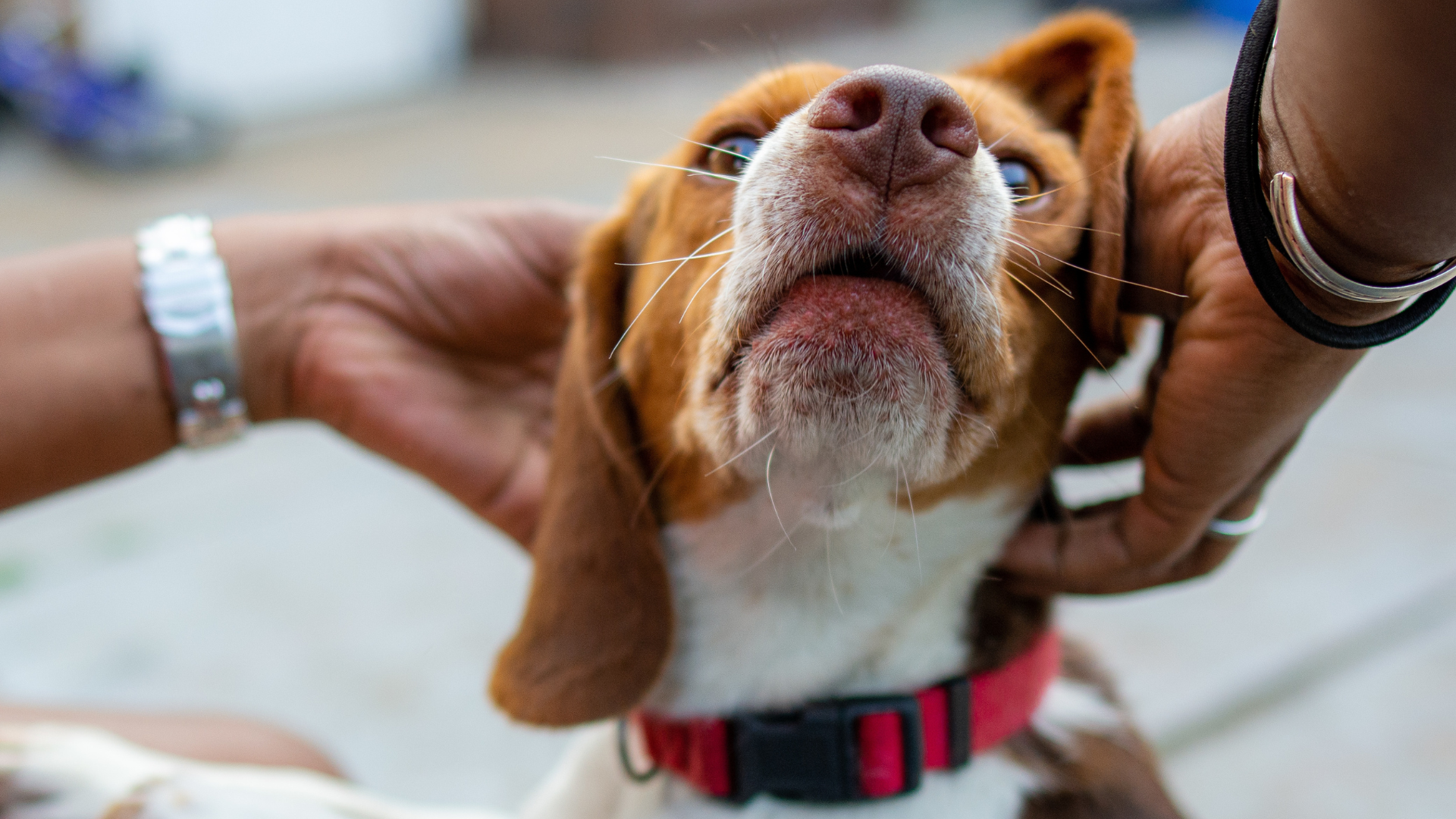Many dog owners may not realize that their furry friends are deaf until it becomes evident through their behavior. Deafness in dogs can be congenital or acquired due to aging, trauma, or infections. As a responsible pet owner, it is important to be able to recognize the signs of deafness in dogs, so that appropriate measures can be taken to ensure their safety and well-being.

One of the most common signs of deafness in dogs is a lack of response to sounds. This can include not responding to their name being called, not reacting to loud noises, or failing to wake up when there is a sudden noise. Dogs may also become more easily startled or frightened, as they are unable to hear approaching people or other animals. It is important to note that some dogs may show selective hearing, where they respond to certain sounds but not others, so it is important to observe their behavior in different situations.
Understanding Deafness in Dogs
Deafness in dogs can be congenital or acquired. Congenital deafness is present at birth and can be caused by genetic factors or a malformation in the ear. Acquired deafness, on the other hand, develops later in life and can be caused by a variety of factors such as infections, trauma, or exposure to loud noises.
Types of Deafness
There are two types of deafness in dogs: conductive and sensorineural. Conductive deafness occurs when sound waves are not transmitted properly through the outer or middle ear. Sensorineural deafness, on the other hand, occurs when there is damage to the inner ear or the auditory nerve.
Common Causes
There are several common causes of deafness in dogs, including:
- Infections such as otitis media or externa
- Trauma to the ear or head
- Exposure to loud noises
- Aging
- Certain medications
Breeds at Higher Risk
Some dog breeds are at higher risk of congenital deafness than others. Breeds with a high incidence of congenital deafness include Dalmatians, Cocker Spaniels, English Setters, Boston Terriers, and Australian Cattle Dogs. Deafness in these breeds is often linked to certain coat color patterns such as merle or piebald, as well as blue eyes and white coat.

In conclusion, understanding deafness in dogs is important for owners to recognize the signs and provide appropriate care. If you suspect your dog may be deaf, consult with your veterinarian for a proper diagnosis and treatment plan.
Identifying Deafness in Dogs
Deafness in dogs can be a challenging condition to identify, especially if you are not familiar with the signs and symptoms. However, with careful observation and a few simple tests, you can determine if your dog is deaf. Here are some ways to identify signs of deafness in dogs.
Signs and Symptoms
There are several signs and symptoms that may indicate that your dog is deaf. These include:
- Unresponsive to sounds
- Excessive barking
- Shaking or tilting their head
- Failure to respond to high-pitched sounds
- Startles easily
Behavioral Indicators
In addition to the physical signs, there are also behavioral indicators that may suggest your dog is deaf. These include:
- Sleeping more than usual
- Difficulty waking up
- Disorientation or confusion
- Increased aggression or fearfulness

At-Home Hearing Tests
If you suspect your dog may be deaf, there are some simple at-home tests you can perform to confirm your suspicions. These tests include:
- Clapping your hands loudly behind your dog to see if they turn their head
- Making a loud noise, such as dropping a book, to see if your dog reacts
- Whistling or making other high-pitched sounds to see if your dog responds
If you notice any signs or symptoms of deafness, or your dog fails any of the at-home tests, it is important to seek veterinary care. Your veterinarian can perform a thorough examination and recommend further testing or treatment options.
Diagnosis and Testing
Professional Evaluation
If a dog owner suspects that their dog may be deaf, it is important to take the dog to a veterinarian for a professional evaluation. The veterinarian will perform a physical exam on the dog to rule out any medical conditions that may be causing the hearing loss. They will also ask the owner about the dog's behavior and response to sounds.
The BAER Test
If the veterinarian suspects that the dog may be deaf, they may recommend a brainstem auditory evoked response (BAER) test. This test measures the electrical activity in the dog's brain in response to sound. The BAER test is considered the most reliable and accurate way to diagnose deafness in dogs.
During the BAER test, electrodes are placed on the dog's scalp and earflaps. The electrodes measure the electrical activity in the dog's brain in response to sounds of different frequencies and intensities. The results of the test can determine if the dog is deaf in one or both ears and the degree of hearing loss.
It is important to note that the BAER test must be performed by a trained professional and is not available at all veterinary clinics. The test is typically performed by a veterinary neurologist or a specialist in veterinary ophthalmology.
Overall, if a dog owner suspects that their dog may be deaf, it is important to seek a professional evaluation from a veterinarian. If necessary, the BAER test can provide an accurate diagnosis of deafness in dogs.
Living with a Deaf Dog
Living with a deaf dog can be a unique and rewarding experience. However, it can also present some challenges. In order to make the most of your relationship with your deaf dog, it is important to understand how to communicate effectively and create a safe environment.

Training and Communication
Training a deaf dog requires a different approach than training a hearing dog. Hand signals are the most effective way to communicate with a deaf dog. It is important to establish a set of clear and consistent signals for basic commands such as sit, stay, and come. Using treats as positive reinforcement can also be helpful in training.
Patience is key when working with a deaf dog. It may take longer for them to learn commands and behaviors, but with consistent training and positive reinforcement, they can become well-trained and obedient.
Creating a Safe Environment
Living with a deaf dog requires special attention to safety. It is important to keep your deaf dog on a leash or in a fenced area to prevent them from wandering off or getting into dangerous situations.

It is also important to make your home a safe environment for your deaf dog. This includes removing any potential hazards such as toxic plants or sharp objects. Using visual cues such as colored mats or lights can also help your deaf dog navigate their surroundings.
Building a Strong Bond
Living with a deaf dog can be a wonderful opportunity to build a strong bond with your pet. It is important to spend quality time with your dog, engaging in activities such as playtime and walks.
Verbal commands may not be effective with a deaf dog, but physical touch and affection can go a long way in building a strong relationship. With patience, understanding, and consistent training, living with a deaf dog can be a rewarding experience for both you and your pet.
Health and Care
Deafness in dogs can be caused by a variety of factors, including infections, diseases, and genetic predisposition. As a dog owner, it is important to take care of your pet's health and ensure that any underlying conditions are addressed promptly. Here are some tips to help you prevent ear infections and address underlying health issues that can lead to deafness in dogs.
Preventing Ear Infections
Ear infections are a common cause of deafness in dogs. They can be caused by a variety of factors, including bacteria, yeast, and allergies. To prevent ear infections, it is important to keep your dog's ears clean and dry. This can be done by wiping the inside of the ear with a clean, dry cloth after bathing or swimming. You can also use a commercial ear cleaner recommended by your veterinarian.
Another way to prevent ear infections is to avoid exposing your dog to allergens that can cause inflammation in the ear canal. This can include pollen, dust, and certain types of food. If your dog is prone to ear infections, your veterinarian may recommend a special diet or allergy medication.
Addressing Underlying Health Issues
Deafness in dogs can also be caused by underlying health issues, such as chronic ear infections, ruptured eardrums, or diseases like diabetes or hypothyroidism. If your dog is deaf or showing signs of hearing loss, it is important to have them examined by a veterinarian.
Your veterinarian may perform a physical exam and run diagnostic tests to determine the underlying cause of your dog's deafness. Treatment will depend on the underlying condition, but may include medication, surgery, or lifestyle changes.
Overall, taking care of your dog's health and addressing any underlying health issues promptly can help prevent deafness and ensure that your pet lives a long, healthy life.
Breeding and Genetics
Hereditary Deafness
Deafness in dogs can be hereditary, meaning it is passed down from parent dogs to their offspring. The most common type of hereditary deafness in dogs is cochleosaccular degeneration, which affects the cochlea and the vestibular system. Another type of hereditary deafness is neuroepithelial degeneration, which affects the nerve cells in the inner ear.

It is important to note that not all breeds are equally susceptible to hereditary deafness. Some breeds, such as Dalmatians and English Setters, have a higher incidence of hereditary deafness than others. Breeders should be aware of the potential for hereditary deafness in their dogs and take steps to prevent it from being passed down to future generations.
Ethical Breeding Practices
Breeding dogs with a known risk of hereditary deafness can be unethical if proper precautions are not taken. Breeders should have their dogs tested for deafness before breeding them and should only breed dogs that are not affected by the condition. Additionally, breeders should avoid breeding dogs that have a history of hereditary deafness in their bloodline.
It is also important for breeders to be transparent about the risk of hereditary deafness in their dogs. Prospective puppy buyers should be informed of any potential risks and given the opportunity to make an informed decision about whether or not to adopt a deaf dog.
By following ethical breeding practices and being transparent about the risk of hereditary deafness, breeders can help reduce the incidence of deafness in dogs and ensure that future generations of dogs are healthy and happy.
Frequently Asked Questions
- How can I distinguish between my dog ignoring me and actual deafness?
- It can be difficult to distinguish between a dog ignoring you and actual deafness. However, some signs can indicate that your dog may be deaf, such as not responding to sounds, sleeping through loud noises, or not waking up when you enter the room. If you suspect your dog may be deaf, it is best to consult a veterinarian for a proper diagnosis.
- What are the common signs indicating deafness in dogs?
- Common signs indicating deafness in dogs include not responding to sounds, sleeping through loud noises, not waking up when you enter the room, and being easily startled when touched or approached from behind. Dogs may also tilt their head or have difficulty with balance, as the inner ear plays a significant role in these functions.
- Which dog breeds are more likely to experience hearing loss?
- Certain dog breeds are more likely to experience hearing loss, such as Dalmatians, Australian Cattle Dogs, and Jack Russell Terriers. However, any dog can develop hearing loss, regardless of breed or age.
- What techniques can I use at home to assess my dog's hearing ability?
- There are several techniques that you can use at home to assess your dog's hearing ability. One technique is to make a loud noise, such as clapping your hands, and observing your dog's response. Another technique is to call your dog's name from another room and observe if they respond. If you suspect your dog may be deaf, it is best to consult a veterinarian for a proper diagnosis.
- How can I determine if my dog has lost hearing in one ear?
- To determine if your dog has lost hearing in one ear, you can perform a simple test by making a noise on one side of your dog's head and observing their response. If your dog does not respond to the noise on one side, it may indicate hearing loss in that ear. However, it is best to consult a veterinarian for a proper diagnosis.
- At what age are dogs more susceptible to developing deafness?
- Dogs can develop hearing loss at any age, but they become more susceptible to developing deafness as they get older. Senior dogs are more likely to experience hearing loss due to age-related changes in the inner ear. However, deafness can also occur in younger dogs due to genetic factors or exposure to loud noises.




